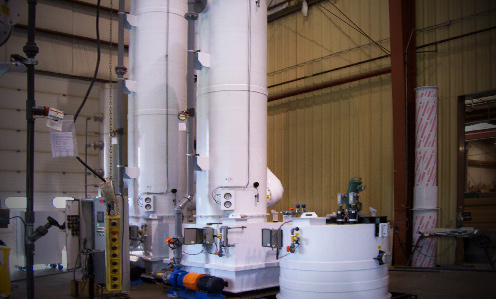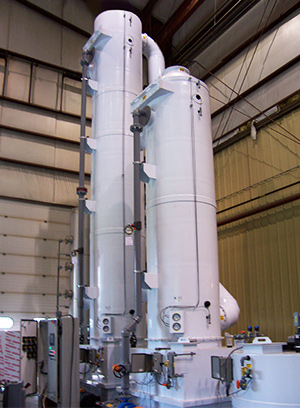

 Downloads
Downloads Case Studies
Case StudiesTri-Mer systems are ideal for continuous performance applications
Applications include chemical plants, petrochemical facilities, municipal waste treatment, asphalt manufacturing, foundries and food processing.
Tri-Mer odor control scrubbers are guaranteed to reduce odors from onion and meat cooking processes. Performance against specific compounds which testing has identified as being present in measurable quantities and which are known to have offensive odors are outlined below:
Hydrogen sulfide: For inlet concentrations up to 4000 ppb, the concentration at the outlet or the odor control system will be less than 1 ppb. This is the lowest reported odor concentration.
Methyl mercaptan: For inlet concentrations up to 100 ppb, the concentration at the outlet for the odor control system will be less than 0.05 ppb, which is within the range of reported odor threshold concentrations.
Dimethyl sulfide: For inlet concentrations up to 1000 ppb, the concentration at the outlet for the odor control system will be less than 0.3 ppb. This is the lowest reported odor threshold concentration.
Carbon disulfide: For inlet concentrations up to 100 ppb, the concentration at the outlet for the odor control system will be less than 16 ppb, which is the lowest reported odor threshold concentration.
n-Propyl mercaptan: For inlet concentrations up to 2200 ppb, the concentration at the outlet for the odor control system will be less than 5 ppb.
Typical Multi-Stage Industrial Odor Control Design |
||
|---|---|---|
| Stage 1 |  |
The gas is contacted with an acetic scrubbing liquid to neutralize the ammonia emission. H2SO4, at 10% concentration, is used down to a pH of 2. High-efficiency Tri-Packs packing media is an integral part of the system; load inlet ppm determines packing depth. Scrubbing efficiency in all cases is to below detectable limits. |
| Stage 2 |  |
Air is contacted with an alkali scrubbing liquid such as sodium hydroxide. Sodium hypochlorite and similar oxidizers may be added to enhance scrubber efficiency. |
Tri-Mer odor control systems can simultaneously handle other contaminants in addition to the specific odor for which they’re engineered. These contaminants include particulate, other inorganic compounds and reactive materials including acids and other gases native to industrial processes.

Many Tri-Mer systems have a dual tower design, with packing depth determined by odor composition and efficiency required. This engineering concept is the most efficient due to counterflow operation. The system allows optimum control of recirculation solution chemical concentrations. The Crossflow design is ideal for situations with dimensional constraints.
The ease with which Tri-Mer systems can be modified to accommodate new conditions is a key reason why Tri-Mer systems are among the most widely-specified in the world for control of industrial and municipal odors.
Some applications require activated carbon in addition to the wet scrubber section to properly control odors. Carbon beds are available from Tri-Mer in vertical and horizontal formats.
Where applications generate particulate as well as odors, Tri-Mer’s Whirl / Wet dust collector can be incorporated.